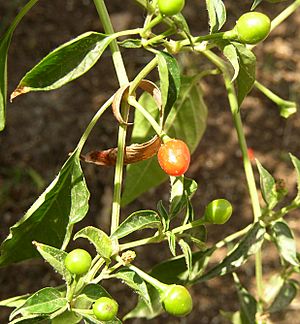Chiltepín facts for kids
Quick facts for kids Capsicum annuum var. glabriusculum |
|
|---|---|
 |
|
| Scientific classification |
|
| Kingdom: | Plantae |
| Clade: | Tracheophytes |
| Clade: | Angiosperms |
| Clade: | Eudicots |
| Clade: | Asterids |
| Order: | Solanales |
| Family: | Solanaceae |
| Genus: | Capsicum |
| Species: | |
| Varietas: |
C. a. var. glabriusculum
|
| Trinomial name | |
| Capsicum annuum var. glabriusculum (Dunal) Heiser and Pickersgill
|
|
| Synonyms | |
|
|
| Chiltepín | |
|---|---|
| Heat | |
| Scoville scale | 50,000–1,628,000 SHU |
The Chiltepin pepper (scientific name: Capsicum annuum var. glabriusculum) is a type of wild chili pepper. It grows naturally in southern North America and northern South America. People call it by many names, like Indian pepper, chiltepe, and chile tepin. It's also known as turkey, bird’s eye, or just bird pepper. This is because wild birds love to eat these peppers and help spread their seeds. The word Tepin comes from an old Nahuatl word that means "flea", probably because the peppers are so small.
The chiltepin is thought to be the ancestor of many common domesticated peppers we eat today. Another small pepper, the 'Pequin', is often confused with the chiltepin. But you can tell them apart! Chiltepin fruits are round or slightly oval. Pequin peppers are oval with a small point. Their leaves, stems, and overall plant shapes are also quite different.
Contents
What the Chiltepin Plant Looks Like
Chiltepin is a shrub that grows year after year. It usually reaches about 1 m (3.3 ft) tall. Sometimes, in places where winter doesn't bring hard frost, these plants can live for a very long time, even 35 to 50 years!
The Fruit: Tiny and Fiery
The chiltepin peppers are tiny. They are usually red or orange-red and slightly oval-shaped. They are about 0.8 cm (0.31 in) across. Some types of chiltepin peppers are perfectly round when fresh. Even if they are a bit oval when fresh, they look very round once they are dried.
Chiltepin peppers are known for being very hot! Their heat is measured using the Scoville scale. They can range from 50,000 to an amazing 1,628,000 Scoville units. To give you an idea, this means a chiltepin can sometimes be hotter than a habanero pepper! The highest heat levels are often found in green fruits about 40 to 50 days after they form.
The heat of wild chiltepin peppers can change a lot each year. This depends on how much rain falls in the Mexican desert where they grow. In dry years, the peppers might not be as hot. In years with normal rainfall, they can be super spicy! Also, the heat level varies depending on if the pepper is fresh green, fresh red-ripe, dried whole, or dried with seeds removed. They get hotter in that order. About 50 tons of chiltepin peppers are harvested each year in Mexico, mostly in the Sonora region.
In Mexico, people describe the heat of the chiltepin as arrebatado. This means "rapid" or "violent". The heat hits you fast and strong, but it doesn't last very long. This is different from the 'Pequin' pepper. Even though the 'Pequin' is the same size, its heat feels different.
You can also tell chiltepin and 'Pequin' peppers apart by how they are dried. Chiltepins are always dried in the sun. 'Pequins' are often dried over wood smoke, which gives them a smoky smell. 'Pequins' are not as hot as chiltepins (only about 30,000–50,000 Scoville units). However, their heat builds up slower and lasts much longer.
Where Chiltepin Peppers Grow
You can find C. a. var. glabriusculum growing in several places. These include Texas, Arizona, and Florida in the Southern United States. They also grow in the Bahamas, the Caribbean, Mexico, Central America, and Colombia.
These peppers like soil that drains water well, like silty or sandy soil. In places like Puerto Rico, they need about 800–2,000 mm (31–79 in) of rain each year. They can grow in areas where the forest canopy is broken, or in places that have been disturbed and don't have many trees, as long as the soil and moisture are good. In other areas, like Arizona, they might need some shade from a "nurse plant" to help them grow.
A Symbol of Texas
In 1997, the chiltepin was named "the official native pepper of Texas". This happened two years after the jalapeño became the official pepper of Texas.
Protecting the Chiltepin
In 1999, a group called Native Seeds/SEARCH teamed up with the United States Forest Service. They created the 2,500-acre (1,000 ha) Wild Chile Botanical Area. This special area is located in the Rock Corral Canyon near Tumacacori, Arizona. It helps protect a large group of C. a. var. glabriusculum plants. This area is used for studying the peppers and keeping their unique genes safe for the future.
See also
 In Spanish: Chiltepín para niños
In Spanish: Chiltepín para niños



